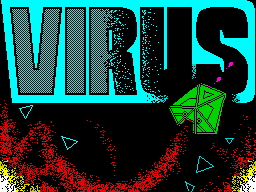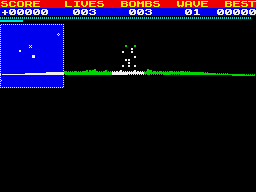Retro Replay Review
Gameplay
Virus offers a tense, fast-paced shooter experience that demands both precision and quick thinking. From the moment you take off in your spaceship, you’re balancing thrust, direction, and altitude to navigate a hostile, virus-infested landscape. Each level’s success is measured not only by the number of alien foes you eliminate but by the percentage of land that remains uninfected when you touch down. This dual objective creates a constant push-and-pull between aggressive offense and cautious resource management.
(HEY YOU!! We hope you enjoy! We try not to run ads. So basically, this is a very expensive hobby running this site. Please consider joining us for updates, forums, and more. Network w/ us to make some cash or friends while retro gaming, and you can win some free retro games for posting. Okay, carry on 👍)
The core control scheme rewards skillful piloting: slight over-thrust and you risk crashing into a tree or overshooting an objective; under-thrust and you’ll be sitting ducks for swarms of alien invaders. A handy scanner gives you a real-time readout of nearby threats, but interpreting its signals on the fly adds another layer of challenge. Veteran players will appreciate how each mission forces you to juggle multiple priorities—rescuing survivors, containing the viral spread, and securing extraction points before time runs out.
Progression in Virus is satisfying thanks to its level-based structure. Early stages serve as a gentle tutorial in gravity management and scanner usage, but once new virus strains and tougher alien variants appear, the pressure ramps up dramatically. Every successful clearance earns you a higher uninfected-land score, encouraging repeated runs to perfect your approach. This leaderboard-like element transforms what could be a straightforward single-player campaign into a compelling arcade-style gauntlet.
Graphics
Visually, Virus embraces a minimalist, remote-3D aesthetic that feels both retro and futuristic. The patchwork-quilt ground effect—composed of brightly colored hexagons or squares—creates clear landmarks for navigation while avoiding visual clutter. Trees and other obstacles protrude from this checkerboard terrain, providing both cover for aliens and hazards for your ship. Their simple, angular models contribute to the game’s distinctive style without overtaxing the hardware.
The alien designs stand out against the muted earth tones, with neon-green spores and pulsating viral clusters hinting at a biological horror beneath their sleek exteriors. Effects like thruster plumes, viral contamination spreads, and terrain deformation are handled with crisp particle animations. When an area becomes infected, the ground tiles shift color in real time, providing vital feedback on your success and adding a visceral urgency to every firefight.
While Virus doesn’t chase photorealism, its visual clarity is a major asset in high-stakes gameplay. You can instantly identify whether you’re gaining or losing ground thanks to clearly defined color palettes. The dynamic lighting—especially during dusk or dawn mission variants—enhances immersion by casting long shadows from the trees and spacecraft, reminding you that gravity and terrain are as much obstacles as the alien virus itself.
Story
The narrative in Virus is straightforward but effective: Earth is under siege by an extraterrestrial pathogen, and humanity’s last hope lies in the pilots brave enough to confront the outbreak head-on. Each mission briefing outlines new viral strains and outbreak zones, giving context to the shifting battlefronts. While there’s no lengthy cutscene drama, in-game text logs and voice-over updates fill in the stakes as the crisis deepens.
Characterization is kept to a minimum, focusing instead on the collective struggle rather than individual hero arcs. This approach lets the gameplay shine without bogging players down in exposition. Still, occasional snippets—like intercepted alien communications or distress calls from besieged colonies—add flavor and heighten the sense of an escalating global emergency. You’re not just blasting targets; you’re racing against an unstoppable viral tide threatening all life on the planet.
The story pacing complements the level design perfectly. Early missions feel like reconnaissance runs, gently introducing mission mechanics and the looming viral threat. Mid-to-late campaign stages shift towards desperate defensive operations, where keeping even small pockets of territory uninfected feels like a meaningful victory. By the final missions, the narrative arc reaches a satisfying crescendo, reminding you why each uninfected tile on the map matters.
Overall Experience
Virus delivers a compelling blend of arcade-style shooting and strategic urgency. Its unique scoring system—based on the percentage of land you save—keeps every run feeling critical, while the remote-3D visuals and intuitive controls ensure you stay focused on the mission. The learning curve is steep enough to feel rewarding without ever becoming prohibitively difficult.
The game’s replay value is substantial, thanks to leaderboards and tight, bite-sized levels that invite “just one more run” syndrome. Whether you’re chasing a perfect score or simply want to see how far you can push back the viral tide, Virus offers clear goals and instant feedback on your performance. Multiplayer or cooperative modes would have been a welcome addition, but as a solo challenge, it excels in keeping tension high and stakes clear.
For players seeking a shooter that combines technical piloting skills with time-based strategy, Virus stands out as a refreshing entry. It may not feature sprawling open worlds or sprawling narrative threads, but its focused design and engaging gameplay loop provide hours of adrenaline-fueled fun. If you’re ready to take on an extraterrestrial pandemic and wrestle gravity to save Earth, Virus deserves a spot in your library.
 Retro Replay Retro Replay gaming reviews, news, emulation, geek stuff and more!
Retro Replay Retro Replay gaming reviews, news, emulation, geek stuff and more!









Reviews
There are no reviews yet.